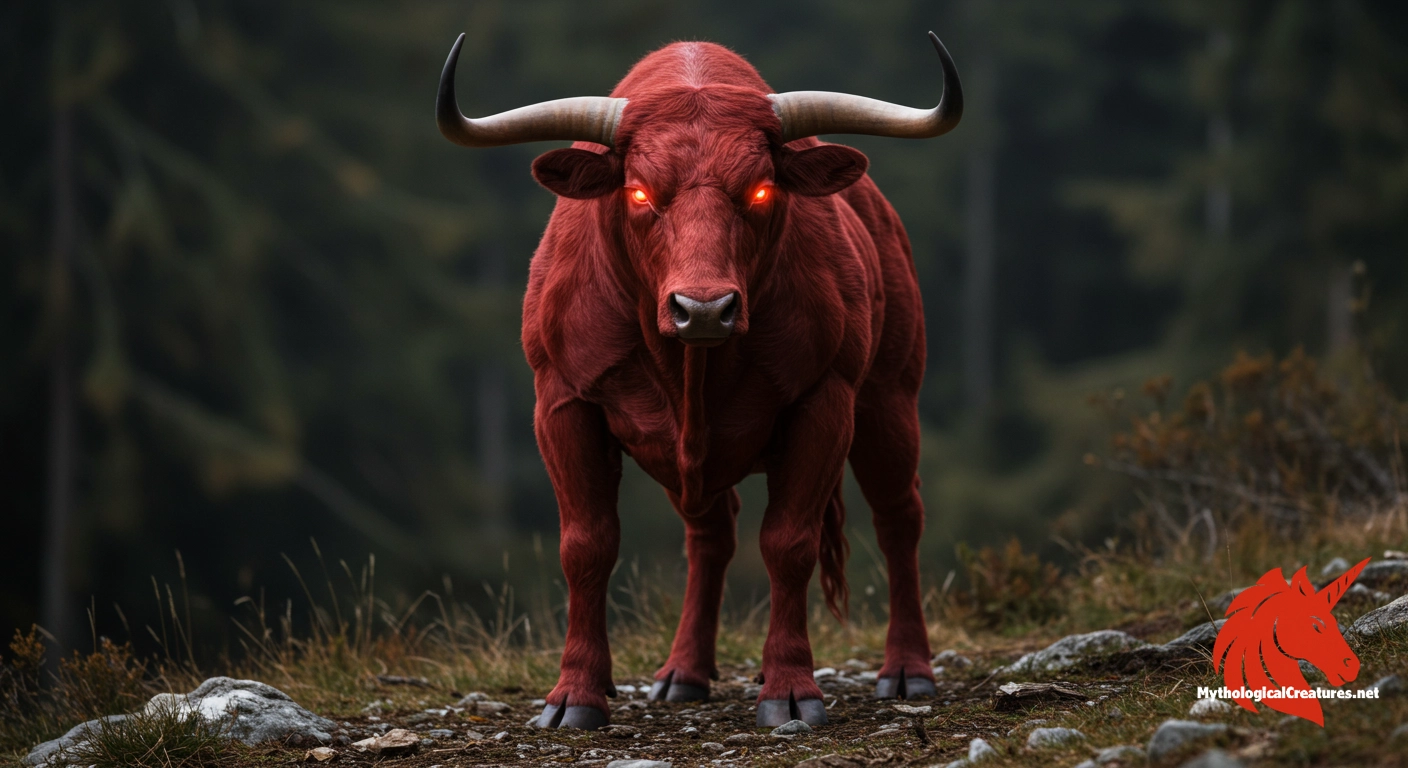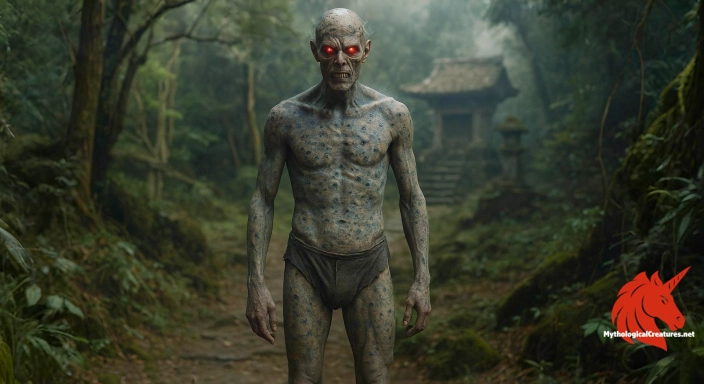Aatxe: Aatxe is a Basque spirit known as the 'Young Bull' who emerges from caves during stormy nights to punish the malevolent.

Aatxe
Aatxe - Represents divine retribution and protection with origins traceable to Paleolithic art and engravings in the Basque region
Origins & First Encounters
Aatxe is a striking figure in Basque mythology, renowned for his dual role as both protector and punisher. His name, a contraction of the word 'aratxe', literally means 'young bull', reflecting the creature’s youthful vigour and robust presence. Born from a rich tradition tied to ancient natural landscapes, he embodies the spirit of untamed wilderness and the age-old struggle between good and ill. Dwelling in secluded caves and dark hollows, his emergence is often associated with stormy nights and a palpable aura of mystery. Over time, his image expanded to include human characteristics, as he sometimes takes on the form of a man, which adds layers of intrigue to his legend. Tales passed down through generations capture his actions in confronting malevolent individuals and reinforcing moral boundaries. His role often intertwines with that of the goddess Mari, suggesting a deeper connection to the earth’s primal forces. The lore of Aatxe has been sustained by an oral tradition that highlights both his wrath against wrongdoers and his protective nature over the innocent. His presence in Basque cultural narratives serves as a reminder of the delicate balance between fear and guardianship. In essence, Aatxe stands as a potent symbol of the enduring power of nature mirrored in myth.
Source Texts & Tale Variants
Ancient rock art and local oral narratives have long preserved the legend of Aatxe, ensuring its survival through countless generations. Detailed engravings and paintings found in regions like Isturits, Sare, and Errenteria depict bulls and aurochs, linking him to prehistoric origins. Varying retellings of his story have emerged from the Basque tradition, each with unique elements that underscore his enigmatic persona. Some accounts highlight his role in punishing those who stray into malevolence, while others accentuate his protective influence during times of danger. Alternate names such as Etsai and Aatxegorri enrich the folklore, offering additional nuances to his mythic identity. Oral storytellers, mystics, and local chroniclers have woven narratives that sometimes portray him in human form, blending the boundaries between beast and man. His connection to the revered goddess Mari is a recurring theme, hinting at his function as an intermediary of divine retribution. Diverse versions of the legend reflect the complexities inherent in any ancient myth, where multiple perspectives add depth to the creature’s character. The rich tapestry of these narratives not only bolsters his mythic persona but also invites ongoing reinterpretation. This continuous evolution of his story underscores the lasting impact of Basque cultural practices on local identity.
Form & Powers
The physical depiction of Aatxe is as compelling as the legends themselves, steeped in symbolism and raw vitality. He is most famously depicted as a young red bull, with a coat that shines with a deep, vivid hue reflecting the intensity of natural forces. His muscular frame is accentuated by gracefully curving horns, which serve as emblems of his formidable power and resilience. In many stories, his eyes are described as blazing with an inner fire, lending him an aura of both mystery and danger. At times, he is said to transform into a human form, yet traces of his bovine nature—such as a certain wild intensity—remain unmistakable. His red-brown hide is often portrayed with an almost supernatural glow, capturing the imagination of those who recount his tales. Artistic renditions frequently highlight a dynamic interplay between the creature’s animalistic strength and subtle human characteristics. Changes in his portrayal, sometimes subject to the teller’s cultural lens, suggest a fluidity in how his form is perceived. Every image of Aatxe encapsulates a harmony between beauty and menace, reinforcing his role as a force of nature. This intriguing physical duality continues to inspire both awe and scholarly interest in Basque folklore.
Regional Faces
The depiction of Aatxe varies notably across different localities within the Basque region, each community colouring the myth with its own cultural nuances. In some villages, he is seen primarily as a red bull that symbolises raw, untamed energy, while in other areas his transformation into a man adds an extra layer of complexity. Certain communities accentuate his role as a guardian, emphasising his capacity to protect inhabitants during dire moments. In contrast, some regions focus heavily on his punitive side, where he is invoked as a stern enforcer of moral codes. The local art forms, including engravings and murals, often adjust the intensity of his features to mirror regional aesthetics and values. Festivals and rural rituals sometimes incorporate elements of his lore, demonstrating a local pride in the creature’s storied past. Even neighbouring areas exhibit subtle differences in his portrayal, suggesting that his symbolism adapts to reflect community-specific experiences. This regional diversity enriches the myth, transforming Aatxe into a versatile symbol that speaks to both fear and hope. The variations in his character serve as a cultural bridge, linking ancient traditions with local identity. Overall, these adaptations highlight the dynamic relationship between myth and the everyday life of the Basque people.
Cultural Parallels
Across a range of mythological traditions, the figure of a powerful bull or bull-like spirit appears as a compelling symbol, much like Aatxe in Basque lore. In several Mediterranean cultures, red bulls or similar creatures serve as potent emblems of strength and natural force, their roles fluctuating between protectors and avengers. Comparative myths often draw parallels between Aatxe and other animal deities that embody the natural world's unpredictable power. For instance, while the legendary Minotaur is remembered as a singular monster, Aatxe is celebrated for his dual nature, which blends both benevolent and retributive aspects. Similar to bovine figures in Celtic and Indian mythologies, Aatxe represents a bridging of human and animal realms, emphasising themes of fertility, raw vitality, and moral oversight. These cross-cultural connections reveal a shared symbolic language in which the bull serves as a repository for societal fears and aspirations. The transformation of such figures into guardians against chaos is a recurring motif, reinforcing their relevance in moral storytelling. This comparative framework not only highlights Aatxe’s unique attributes but also situates him within a broader mythological context. By aligning his narrative with those of similar creatures worldwide, his legend becomes part of a larger tapestry of myth that transcends regional boundaries. Ultimately, these parallels enrich our understanding of how different cultures perceive the interplay between nature, humanity, and the divine.
Legacy & Modern Evolution
Over the centuries, Aatxe has transitioned from a fearsome mythic spectre into a symbol rich with cultural significance in modern Basque identity. His ancient roots, traced through cave art and enduring oral traditions, lend a timeless quality that resonates with contemporary audiences. Early depictions of a wild, red bull have gradually evolved, influenced by shifts in artistic interpretation and broader social changes. Today, his image can be found in modern literature, visual art, and regional festivals, all of which reflect a renewed appreciation for traditional folklore. Modern reinterpretations often blend elements of fantasy with historical authenticity, allowing Aatxe to serve as a bridge between the past and the present. His myth, once a cautionary tale against moral transgressions, now also celebrates the resilience and spirit of the Basque people. The evolving portrayals of this creature mirror changing cultural values, where ancient symbols are reimagined in ways that speak to new generations. As discussions about heritage and identity gain momentum, Aatxe’s role as a cultural icon is increasingly recognised. His enduring presence challenges contemporary narratives and invites a deeper exploration of the region’s mystical origins. Ultimately, the story of Aatxe illustrates the dynamic evolution of myth, ensuring that ancient traditions continue to influence modern life.
Interesting Fact
Ancient cave art and engravings depicting aurochs and bulls throughout the Basque region are believed to be early representations of Aatxe, underscoring its deep Paleolithic origins and lasting cultural impact.
Quick Creature Info
Features:
Associations:
Our Mythic Legendary Rating:

Also Sometimes Known As:
Habitat:
Supernatural Powers:
Physical Attributes:
Abilities:
Behavior:
Lore:
References
Discover Another Mythical Legend You May Not Have Heard Of?
Uncover the mysteries of ancient folklore and expand your knowledge of legendary beings from cultures around the world.
Dare to Meet the Smallpox demon....
Mythical Disclaimer: The images and data on this site are derived from various historical and literary sources, but we have found that many myths often have multiple versions and interpretations across references, sometimes contradictory. As a result, these creature depictions are artistic interpretations—imaginative blends of folklore, legend, and a dash of AI guesswork. Because creature descriptions vary widely, our illustrations and accompanying information represent our best effort to honor mythology while bridging creative gaps. Enjoy these interpretations—just remember, we've done our best to respect the stories and validate available data, but in the realm of mythology, details often shift, imagination leads the way, and nothing is ever set in stone!
Curated by the Mythological Creatures Team (rev. May 2025)
